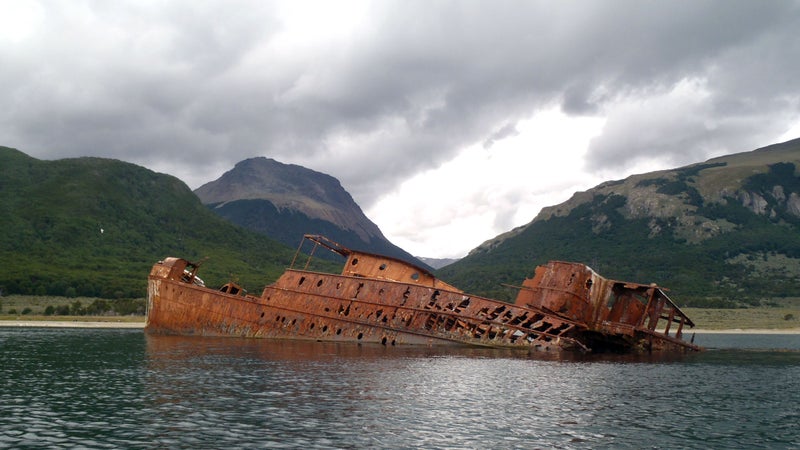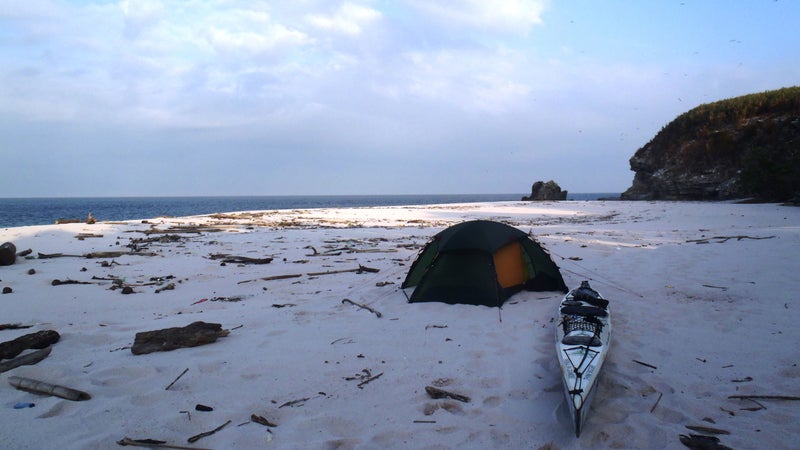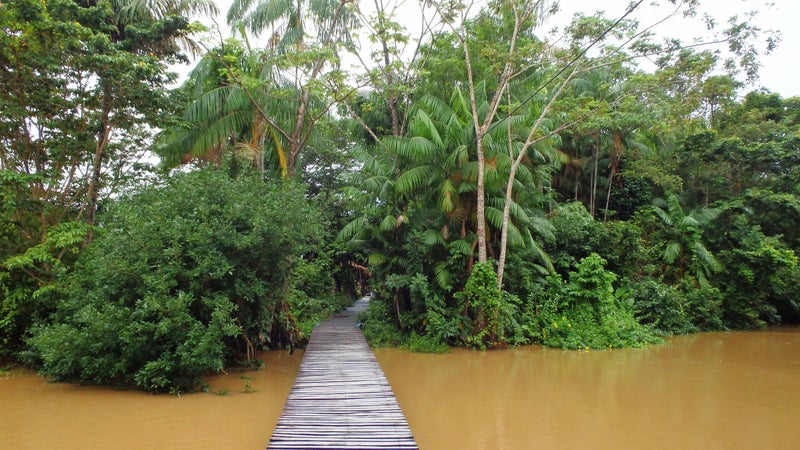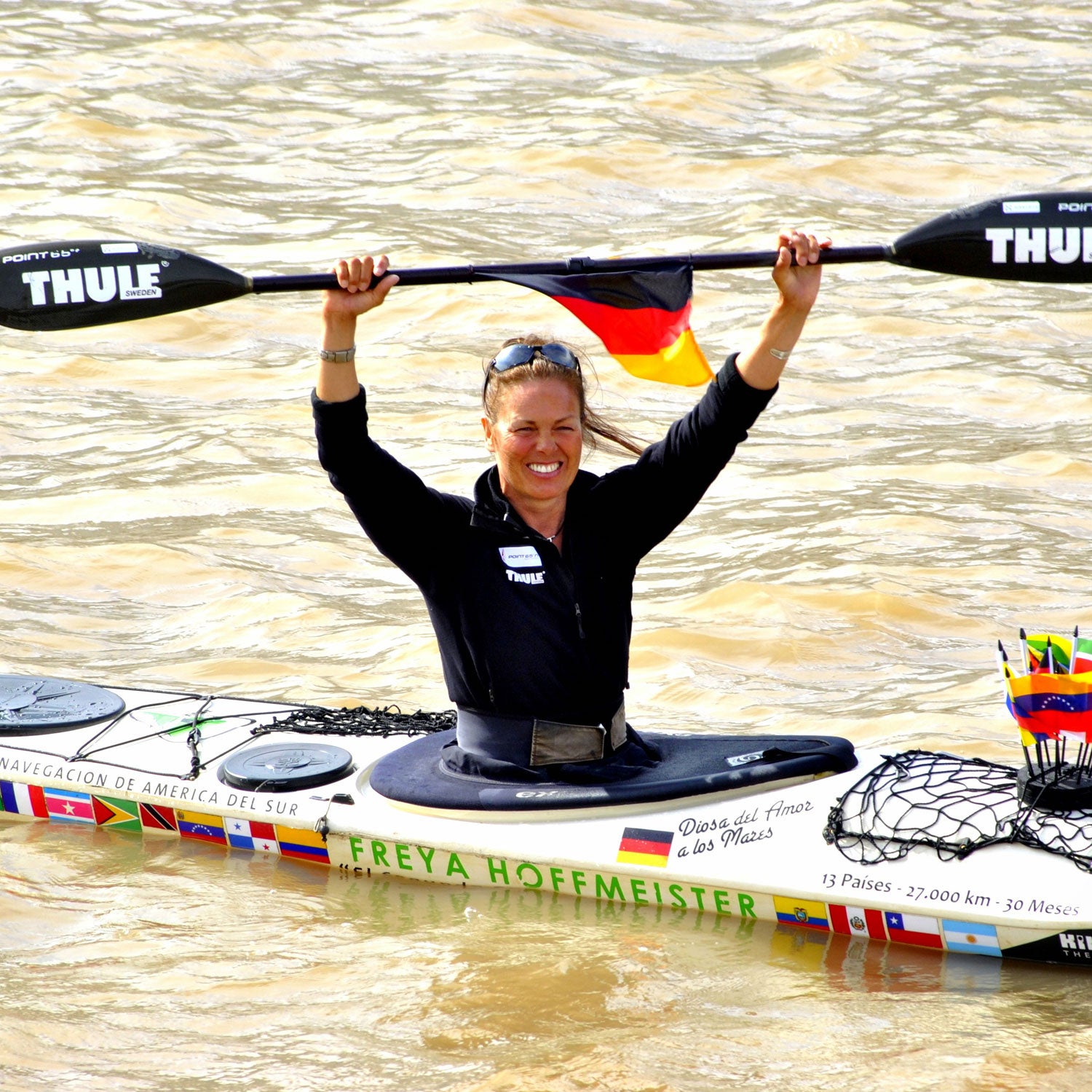On May 1, almost four years after she shoved into the surf off the coast of Buenos Aires and began a clockwise path around the world’s fourth-largest continent, Freya Hoffmeister pulled into port having logged 850 days on the water, 17,000 miles paddled, and one sketchy trip through the Panama Canal.
The 51-year-old German kayaker became the first person to make it around South America under nothing but her own power—the crowning feat of a 19-year kayaking career chock full of massive undertakings. She solo paddled around Australia over 12 months in 2009. The self-proclaimed “Goddess of Love to the Seas” has also circumnavigated Iceland and New Zealand’s South Island, both in 2007. “I call her a paddle-naut, a paddling explorer,” Wade Blackwood, executive director of the , says. He describes Hoffmeister’s South America excursion as “one of the most epic paddles in the last ten years by far.”
Hoffmeister didn’t tackle South America all in one go, but rather broke the trip into sections, each consisting of several months. She took up kayaking in 1996 when she became pregnant with her son and had to give up skydiving, and today runs two ice cream cafes and a Christmas shop in Husum, Germany, where there is easy access to the North Sea. As the business owner, she can afford to take extended breaks to set kayaking records. “The managers and employees do their jobs and do it well without me,” she says, “so they’re probably happy I’m not looking at what they’re doing all day.”
When Hoffmeister accepted her trophy for Sportswoman of the Year at the , she thanked everyone for their support in the journey. “And thanks to God I’m still alive. It could have been different many times.”
Yes, it could have. A land mass as large as South America is rife with challenges. These three��gave Hoffmeister and her ��sea kayak the most trouble:
Cape Horn

Hoffmeister ran into her first bit of trouble 120 days into her trip while rounding the tip of . Pioneers back in the 1600s only dared to navigate these waters in sturdy, full-size vessels, and still struggled against winds and currents both pushing eastward. And here Hoffmeister was tackling it in an 18-foot kayak. She was making progress against the 60-knot winds until—a mile before her destination of Isla Hornos,��the southernmost point of South America—she was blown sidways out of the channel between two islands. “I had to turn around [back to] where I came from,” she says.
But with the wind still hijacking her route, Hoffmeister settled for an impromptu landing on the barren, rocky coast of nearby Isla Deceit, a small spit of an island Hoffmeister says is not meant for a landing. “The boulders are covered with kelp and seaweed, so at least there was a tiny bit of padding for the crash landing on the rocks,” she says.
Sheltering behind one of the boulders, Hoffmeister killed time by reading an e-book, taking pictures, snacking on oats and pasta, and patching her beaten up kayak and paddle with fiberglass and epoxy resin. Five days later, she found her opening in the storm and paddled off.
Panama Canal

Contrasted with the blustery isolation of Cape Horn, the Panama Canal is the ocean’s freeway. More than 13,000 ships—vessels that dwarf cargo freighters that would steamroll Hoffmeister’s kayak without ever knowing it—pass through its 500-foot wide channel each year.��
Hoffmeister’s path to find the shortest, most wind-protected route took her across the shipping lane six times. “You have to judge the ships coming in and you have to judge them quickly,” she said. “It’s amazing, such big ships drive faster than you think.” To put it in perspective, a ship in the canal must be able to reach a top speed of 8 knots. Hoffmeister averaged a little less than 3 knots.
Plus, Hoffmeister couldn’t paddle through the locks—confined sections of the canal that raise and lower the water to help ships climb or drop in elevation. “I would have loved to go through the locks, but no chance. Absolutely no chance,” she says. Instead she portaged—hopped out and carried her kayak on the shore��around them.
Amazon Tidal Bore

Twelve thousand��miles into her trip, on day 612, Hoffmeister was heading southeast along the northernmost coast of Brazil, eating dinner on her boat, and nearing the mouth of the Amazon River. Suddenly, a three-foot tidal bore surged towards the shore, taking her with it.
“That one was catching me because I was too stupid to get proper information,” she says. “I was surfing this wave at night sideways for about 20 minutes at 19 miles per hour.” Earlier this month, , “I was fearing for my life, crying out for help in German, which is surely ridiculous in that situation.”
Hoffmeister was thrown into the water and swept into a side channel, still tethered to the kayak. She had to then excavate the wet sand out of the hull with a spoon.��
In spite of all the obstacles, Hoffmeister downplays the difficulty she soldiered through almost every leg of the trip. “I survived,” she says. “No really serious incidents. I didn’t get robbed or shot at, but I could have been.”
��


